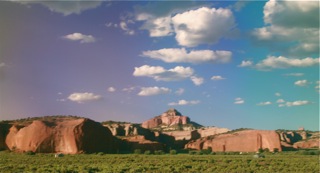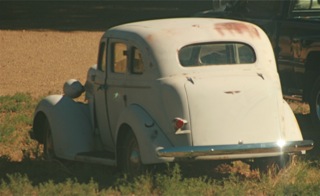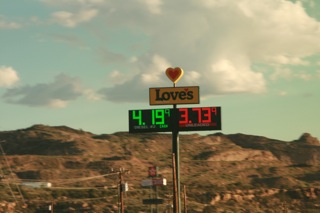A non-profit organization of passenger train enhusiasts devoted to the
presentation and exhibition of Passenger Train History, especially that
of Amtrak.
August
11, 2008
Life in Car 40, Transition Car.
When I
received my ticket for this round trip from Fullerton,
California, to La Plata, Missouri, I noticed that my return trip
roomette to California was for Room 18,
Car 40. I asked Steve Grande, owner of TrainWeb.com, if Car 40
was the Transition Car, a car between the one-level baggage car and the
2-level sleepers and other cars in the consist, usually used for
employees.
He confirmed it and I thought this would be a good chance to see this
seldom-used-by-passengers car. I like the lower level rooms
because it is my opinion that they are smoother and more private since
any through-train movement by passengers is on the upper level.
And, any stored luggage is on the lower level as well as most of the
bathrooms and the only shower in the car.
In the Sleepers, high-numbered roomettes are on the lower level, yet
I'd never seen a roomette 18, so I didn't know if my Transition Car
room would be on the upper or lower level.
As it turned out, the Transition Car has one room on the lower level,
just a 1/2 car Conductor's office with 2 4-place tables, and the normal
set of restrooms and shower, and the one handicapped room.
The upper level of the Transition Car has only roomettes, the front of
the car (next to the baggage car) the roomettes are numbered 1 - 8,
and are for
employees. The back of the car (closest to the next sleepter) are
roomettes 15-24 which are
evidently being sold for revenue.

Sign at the top of the stairs.
|
Transition
Sleeper Car Layout

I had room
18. Rm. 15 is the bedless room with one stable chair.
|
(Double-Click
any photo in this Travelogue to see a double-sized copy; Click BACK in
your browser to return to this page.)
Advantages of Transition Car (40)
- I like the piece and quiet
of the Transition Car and the fact that there are
- more restrooms on the
upper level.
- Also, each restroom has a
shower, so there is no need to go from a dressing/shower room to
a restroom with a sink to accomplish your morning chores. There
is the traditional dressing/shower room on the first level if you
desire the extra room.
- You do hear train announcements
in the 40 Car.
- There is one roomette that has no beds, but it has a
comfortable, armless, swivel chair where you can photograph out both
windows.
Disadvantages of Transition Car (40)
- You are pretty much on your own
in Car 40.
- You are not told by anyone that this is anything but a normal
sleeper car. By that, I mean your
call button calls no attendant since the car next to the 40 car
is also in charge of making beds and tending to passengers in the 40
car. So if you want to find the attendant, who cannot be reached
by the call button, you need to search both levels of the 40 Car, the
adjacent sleeper car, or the diner.
- There are no shower towels in
the bathroom/shower rooms. I asked an employee and she
said they were downstairs. There is no bar soap in the bathroom/shower
rooms upstairs.
- As far as I can tell, the LSA does not come this far on the train
to take dinner and lunch reservations.
For my first meal, I had to go to the diner to get the lunch
reservation.

Half of the lower level of the
Transition Car 40 is labeled the Crew Lounge. This is one side
with a table for 4 and the rest flat floor with trash can.
|

The other half is identical.
|

This is how Train 3's Car 40 was labeled.
Sights from the Southwest Chief in August travelling westward in
Colorado, New Mexico, Arizona, and California
 |

Before
automobiles, there were blacksmith shops, then they became Garages when
automobiles came into being.
|

We had a 2X4
Jeep like this on our Hayden, Indiana, farm.
|

They haven't
made a Ford Tractor like this in 50 years, but in the dry desert
climate, not much rusts.
|

Mining Ghost Town
|
 |

Wootton Ranch
|

|

Going through a
pass like this usually means sharp curves and 25 mph or less, a good
time for photos of your own train.
|

Wooton Ranch
and far peaks from farther up the grade to the Raton Tunnel.
|

Santa Fe put up
a sign like this on both sides of the Tunnel. The west side sign
still has a Santa Fe shield on the top bar of the sign (shown earlier
in this report).
|
Knowing that
this State Line Monument on the Colorado/New Mexico line is immediately
outside the east portal of the tunnel, right us next to the track, I
stood up in my room and looked down to try and photograph it.
Just got it this time!
|
Train
Travel Photo Trip: When you are anticipating a hard-to-get
shot, like the state line marker between Colorado and New Mexico on the
Southwest Chief (above and below), set your camera for a burst of
shots. Other examples of shots when you might use the
Burst/Continuous Mode: Traveling across a Bridge or through a
Snow Shed or along a tree-lined right-of-way when trying to take a
distant mountain range or lake. In each of these cases, you will
have many unusable shots with bridge girders, shed posts, or trees
blocking your view, but with Burst Mode, you will have many images from
which to choose. Check your camera's manual for how to set for
Burst or Continuous Mode. More about this camera setting:
Burst (Continuous)
By Vincent Bockaert
http://www.dpreview.com/learn/?/key=burst
Burst or Continuous Shooting mode is
the digital camera's ability to take several shots immediately one
after another, similar to a film SLR camera with a motorwind. The speed
(number of frames per second or fps) and total number of frames differs
greatly between camera types and models. The fps is a function of the
shutter release and image processing systems of the camera. The number
of frames that can be taken is defined by the size of the buffer where
images are stored before they are processed (in case of a before image
processing buffer) and written to the storage card.
The number of frames per second (fps)
and total number of frames that can be shot in burst mode is
continuously improving and is of course higher as you move from
consumer and prosumer digital compacts to prosumer and professional
digital SLRs. Digital compacts typically allow 1 to 3 fps with bursts
of up to about 10 images while digital SLRs have fps of up to 7 or more
and can shoot dozens of frames in JPEG and RAW. Some even allow an
initial burst of higher fps followed by a slower but continuous fps
until the storage card is full.

|

On the west
side of the Raton Tunnel, going down grade toward Raton, New Mexico,
are cattle farms. In this case two windmills are being used to
pump water from wells to cattle troughs.
|

I counted about
34 insulators (green and clear) on the crossbars of each trackside pole.
|

Downtown Raton,
NM, where Boy Scouts board and detrain for their summer camp at
13,744-acre Philmont Boy Scout Ranch.
|
Las Vegas (The Fertile valleys)
Starvation Peak, On the Santa Fe Trail (above)
Santa Fe Trail New Mexico (NM)
This majestic eminence rises abruptly
about fifteen miles west of Las Vegas, New Mex., and is visible most of
the beautiful journey through mountainous scenery between Las Vegas and
the Ancient City of Santa Fe. Legend has it that in early days a
detachment of Spanish soldiers sought refuge on this peak, but being
surrounded by Indians, sought death by starvation rather than torture
at the hands of the Indians.
Things looked pretty normal as we pulled
into Lamy, NM. However, as we stopped on the west end of the
station, it was a movie set! They were set up on top of the coach
on the west side of the station with their cameras, a stunt man was
practicing on top of the east end of the car, with safety harness
attached. The multinational film crew seemed interested in
photographing the SWC as we were spotted for passengers.

He detached the
safety cable and came down from the car top.
|
 |

This Santa Fe Southern, from
Santa Fe, is a tourist train by day and beer train by
night...transporting Bud from a regional warehouse to the main line at
Lamy.
|

I like this
adobe church on the southwest side of Lamy, facing the tracks.
|
To read my Santa Fe Southern
Rail Travelogue, click
here.

For years, this
was the Amtrak Station, which is still standing.
|

It was warm in
ABQ, so I made it back to my Roomette 18 in Car 40.
|

Some SWC
passengers made it to the ice cream shop just past the parking
structure, below the clock.
|

I returned to
the train through the Transportation, past the Amtrak Ticket Office and
waiting room.
|

South of ABQ as
we waited on the main line at Corrhuente at Dalies Rd. I could see a
stable freight awaiting an eastbound freight.
|

Then I saw a
rare freight train meet in the desert. Rare in that this picture
was taken from a train.
|

As the sun
began to set on my full day on the westbound Southwest Chief, the New
Mexico landscape caught my camera's eye.
|

The Best Picture I NEVER took.
Not until after I
looked this photo did I notice the rare glassy water in the desert
reflecting the Ayers Rock-like vista. Otherwise, I would have
included more of the lake in this photo.
|
Between Albuquerque
and Gallup, along the Southwest Chief's Route, are the RED CLIFFS OF
NEW MEXICO. These hills are known for their changing colors,
especially in the afternoon summer light while I was watching them move
by my window. Legend has it that the rocks got their color from
the blood of a wounded stag as it fled through the hills. --from
the Amtrak Southwest Chief Route Guide.
Don't you love the colorful, Spiritual legends of the Native
Americans? I wish my Native American blood had included
some of that wisdom and colorful language. My 1/16 Native
American blood did evidently include a love for the outdoors, wildlife,
and respect for the land, ancesters, and Spirit Father. My Great
Grandmother was full-blooded Native American.

|

A closer look at the same scene at left.
|

Gallup, NM, the "Indian Capital of the World."
|

|
Gallup,
New Mexico, a meeting place for the Navajo, Hopi, Zuni, Apache,
and Acoma Indians. On the eastbound Southwest Chief, a Tour Guide
boards here and provides a geological and historical talk in the lounge
car to Albuquerque. I presume a westbound guide was on our train
until Gallup.
Route 66 runs parallel to the BNSF tracks through Gallup, so SWC riders
have a good view of the downtown shops and hotels. The lyrics
from
Route 66 include Gallup
and five other towns along the Southwest Chief's Route.
Route
66 penned in 1946 by Bobby Troup
Well if you ever plan to motor west,
Take my way take, that's the
highway that's the best.
Get your kicks on Route sixty-six.
Well it winds from Chicago to LA
More than two-thousand miles all the way.
Get your kicks on Route sixty-six.
Well it goes through St. Louie, Joplin, Missouri
Oklahoma City looks so, so pretty.
You'll see Amarillo, Gallup, New
Mexico
Flagstaff, Arizona, don't
forget Winona,
Kingsman, Barstow, San
Bernardino.
Won't you get hip to this timely tip
And take that California trip.
Get your kicks on route sixty-six.
|








































